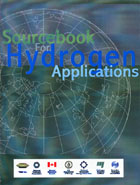
 Enter HyVIEW™
Enter HyVIEW™
Quick Links
| Why Hydrogen?Energy System ChallengesThe Perfect Fuel?What's Happening?Who can Help? |
What's Happening?
What's Happening with Hydrogen?
Our present carbon-based energy system uses the internal combustion engine (ICE) as its main energy conversion device. An alternative, the hydrogen fuel cell (HFC) chemically combines hydrogen and oxygen to produce water vapor and electricity at a higher level of efficiency than the ICE.
The electric current produced by the HFC can be used to power an electric engine Unlike its rival the battery, the HFC decouples energy stored as fuel from power provided by the HFC. Thus, as long as there is fuel available to feed it, a fuel cell remains operational and doesn't run down like a battery, providing the flexibility of the present ICE system. The car in a future hydrogen economy will likely be powered by electricity, but very different from the battery-powered vehicles proposed from the early days of the automotive industry.
Paving the Way
Some countries are making major commitments to hydrogen. Canada, the United States and Germany have led the way with new hydrogen technologies and are gradually increasing their commitments to hydrogen.
Japan, an island nation with few fossil fuel resources, is vulnerable to worldwide energy interdependency. Japan has a major ongoing program to develop a global hydrogen system with new technologies for power plants, cars, buses, planes, ships and rockets, all fueled with renewable hydrogen.
Investment Is Key
Investments of major European, Japanese and North American car makers in fuel-cell technology at the end of the 20th Century recognized that there may be an alternative to hydrocarbon-fueled internal-combustion engines. This is a major step forward for hydrogen by one of the world's largest industrial sectors. It will stimulate public and political acceptance of hydrogen from a market point-of-view in addition to simply promoting its technical merits.
These trends and commitments mean we will begin to feel the presence of hydrogen increasingly in our daily lives. How rapidly this occurs is hard to say. From proposals for projects in our neighborhoods and devices in our homes to the vehicles we drive or ride in, we will continue to be presented with more and more hydrogen-driven options. Consequently, we will need to understand this renewable resource better to make the best decisions.
Turn of the Century Milestones
At the end of the 20th century, a number of dramatic events occurred in the hydrogen industry. Groups of world-leading companies formed strategic alliances with that most important of markets, the automotive transportation industry. These alliances were accompanied by major investments, including those of DaimlerChrysler AG and Ford Motor Company, in Ballard Power Systems for the very important automotive transportation marketplace. We now have the prospect of new hydrogen-fueled vehicles reaching the marketplace early in this new century.
Both large-company consortiums and smaller start-ups have begun to mobilize to meet an emerging market for stationary and portable power generation systems. To support the emerging transportation applications, Stuart Energy Systems has developed new systems for bus, fleet and personal vehicle fueling. Many other companies, large and small, are developing special electrolyzer, fuel cells, and peripheral devices to support the emerging hydrogen society.
We are already witnessing an increased use of the fuel cell, particularly in stationary applications in public buildings where police stations, hotels, and hospitals seem to be emerging as niche applications and as attractive new investment opportunities.

